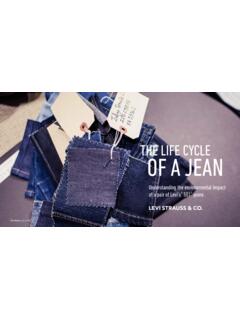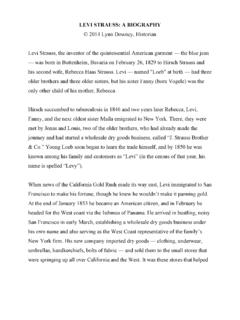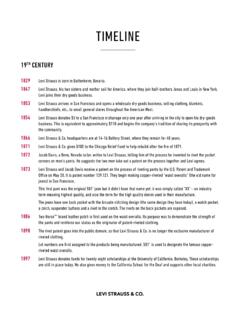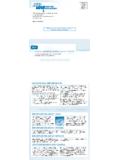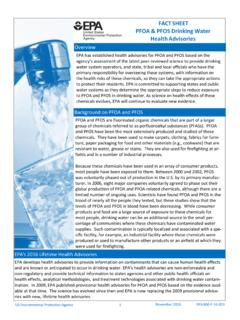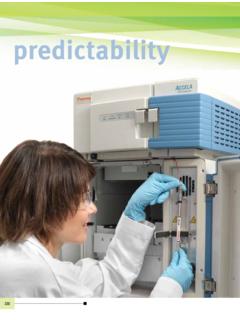Transcription of Case Study on Phase out of Short-Chain C6 …
1 Case Study on Phase out of Short-Chain C6 perfluorinated Chemicals ( pfcs ) from apparel Levi Strauss & Co. May 2016. 1. Substitution case story No. Field Name Explanations 1. Title Phase out of short - chain C6 perfluorinated Chemicals ( pfcs ). from apparel 2. Abstract The Phase -out of PFC containing durable water repellent finishes has been decided by Levi Strauss & Co. For the manufacture of water repellent textile products an alternative PFC free finish is used containing paraffin waxes and blocked isocyanates. 3. Sector Manufacture of textiles, wearing apparel , leather and related products 4. Function Other Functions 5. Process chemical or Biological treatment 6. Reliability phrases Evidence of implementation: there is evidence that the solution was implemented for season Spring 2015.
2 Subsequent seasons following Spring 2015, LS&Co have adopted other chemical suppliers' PFC-free alternative DWR. chemistries. Refer to Addendum. 7. Substituted substance(s) C6-Fluorocarbons 8. Alternative substance(s) Paraffin waxes melamine resin fat modified oxime-blocked isocyanate 9. Other type of alternative 10. Hazard assessment According to the producer's self-classification of the alternative product no hazardous ingredients are listed in the MSDSs. It may produce an allergic reaction. It is free of PFC. No details on the substituted products were known to SUBSPORT. 11. Case description * (see below). 12. Case/substitution evaluation This case story from a user describes the substitution of a Short-Chain PFC (C6 fluorocarbon) containing textile finish with an alternative PFC free finish that is not classified as hazardous.
3 However, it was not possible to perform a full hazard assessment ( potentially hazardous monomers etc.). as the full compositions are unknown to SUBSPORT. The PFC. free finish might be a feasible alternative also for other PFC. containing products, which can have severe negative environmental and health impacts. 13. State of implementation In use 14. Date, when alternative was Spring 2015, Global Distribution implemented and country 2. No. Field Name Explanations 15. Contact: Enterprise using the Levi Strauss & Co alternative 1155 Battery Street San Francisco, CA 94111 USA. 16. Availability of alternative On the market 17. Contact: Producer or supplier of Schoeller Textil USA, Inc. alternative 38R Merrimac Street, Suite 204. Newburyport, MA 01950. 18. Type of information supplier Producer / Distributor 19.
4 Contact: Information supplier Levi Strauss & Co 1155 Battery Street San Francisco, CA 94111..com Linda Gallegos, 20. Other Solutions 1. Highly branched dendrimers and polymers 2. High molecular weight waxes 3. Organic silicon compounds 21. Further information MSDS of the alternative part 1. MSDS of the alternative part 2. 3. Introduction * This case Study will show the steps Levi Strauss & Co. (called below "company") took to eliminate short chain , C6, perfluorinated chemicals ( pfcs ) from its Commuter line of denim and non-denim apparel . Commuter was successfully launched in Fall 2011 using Nanosphere , a C6 perfluorinated chemical formulation marketed by Schoeller Tech, part of Schoeller Textiles and manufactured by Archroma, previously known as The initial Commuter line consisted of men's denim and non-denim pants and jackets targeted for men commuting by bicycle, a growing global trend in the marketplace.
5 The product consisted of denim and non-denim fabric, with performance attributes such as: stretch for mobility and comfort; design details targeted for cyclists; an antimicrobial for odor management; and a durable water repellent (DWR) to provide protection from rain. Sourcing and developing the fabric with the desired attributes was carefully orchestrated by the company during the development Phase of the work. It required strong technical knowledge to get the water repellent performance, while maintaining a product with the desired aesthetics. For denim, the Nanosphere chemistry was applied at the mill after the denim was desized and before garments were cut and sewn. The denim jean did not have any garment finishing to ensure the level of DWR performance was maximized for the consumer.
6 For non-denim, the Nanosphere chemistry was also applied at the mill during the fabric finishing process in a similar manner. The company used the AATCC 22 water repellency spray test method to test for the performance on the finished fabric as well as garments. Standards were established based on the test results and the expected performance of the products. The Case Study Method 1. Identify the chemical of concern. The company describes the hazard, the function of the substance, and the current conditions to make it work at the desired performance level. 2. Set substitution criteria. Through company's Restricted Substances List (RSL) process, criteria to eliminate alternatives that are not safer have been set. The company also aligns with the regulatory and legal environment of the countries in which the company operates and sells.
7 3. Identify alternatives from chemical suppliers. The company engages with chemical suppliers in dialogue about chemical sustainability, hazard, risk and exposure, and work with them to find safer alternatives for chemicals of concern. 4. Assess and compare alternatives. The company asks chemical supplier to share what hazard assessment methodology and tool they use to identify safer substitutions. 5. Pilot substitution for performance. The company evaluates the chemical through company's processes to ensure the performance meets consumer expectations. 6. Encourage chemical supplier to post substitution case Study . After third-party verification, the company encourages the chemical supplier or other organization to post a substitution case story on the SUBSPORT.
8 The Problem The company identified Short-Chain perfluorinated chemicals (C6) as a class of chemicals to eliminate from its products by December 31st 2015. Following this decision, the company immediately began to search for a 1. Schoeller's Nanosphere technology is considered a state of the art, bluesign approved C6 chemistry 4. replacement for Nanosphere . Currently, Short-Chain pfcs are not regulated, and do not have any harmonized classification according to Annex VI of Regulation (EC) No 1272/2008 (CLP Regulation) The evidence that long- chain pfcs , such as perfluorooctonoic acid (PFOA) and perfluoroocatnesulfonic acid (PFOS), are both hazardous to human health and the environment is well documented. The theory held by certain sectors in the science and NGO communicates is that the molecular structure between the Short-Chain and long- chain pfcs is so similar that Short-Chain pfcs also may be persistent, bioaccumulative and toxic.
9 It should be noted that there is much less available data on Short-Chain pfcs to demonstrate their hazardous nature. Consistent with the precautionary principle, the company made a decision to replace Nanosphere with PFC- free alternatives. Substitution Criteria The company has established a Restricted Substances List (RSL) that restricts the presence of hazardous chemicals on consumer products. It added long- chain pfcs , such as PFOA and PFOS, to the RSL in 2008. The company RSL meets, and in many cases exceeds, all global regulatory requirements. As the company began to search for safer alternatives, it was imperative that the alternative formulations not pose any risks to human health and the environment. Of specific concern was to make sure the alternative chemical was not a regrettable substitution, meaning that it could be just as hazardous as the chemical it was trying to replace.
10 Chemicals that are persistent, bioaccumulative, toxic to the environment, and carcinogenic were particularly important hazard end-points because these are the hazardous attributes associated with long chain pfcs . The Alternative The company wanted to maintain its relationship with Schoeller for several reasons; it is an innovative leader in performance chemistry for textile applications; its marketing strategy is a good fit for the Commuter series; and it is a leader in environmental health and safety in the textile industry. Schoeller launched a PFC-free replacement technology called ecorepel in 2013. It is based on long paraffin chains that wrap themselves around the cotton fibers. This reduces surface tension so that water is repelled off the fabric. The paraffin chains are bound to the fiber by a docking system that is cross-linked by blocked isocyanates.
